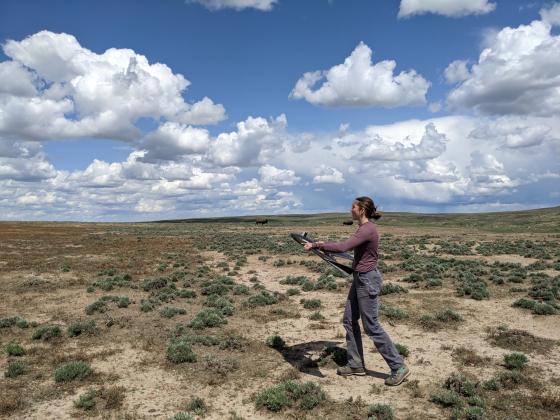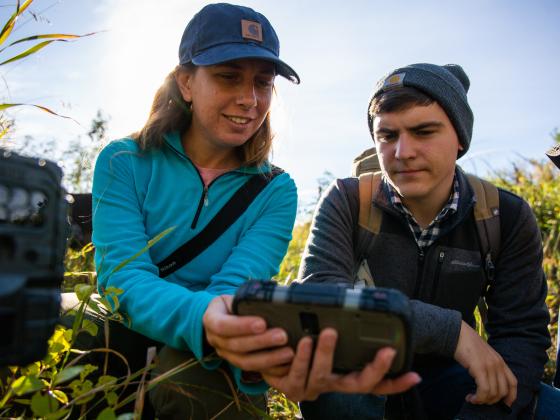OZEMAN – While it’s known for its museums in Washington, D.C., the Smithsonian Institution also comprises dozens of research and education bodies around the world. And through a unique collaboration with one of those teams, faculty and students at Montana State University are amplifying ecological research in the northern Great Plains.
The Smithsonian’s Great Plains Science Program was established in 2018 and since then, scientists in the GPSP have connected and worked with researchers at MSU, bringing together a broad range of academic focus areas to study a bioregion with numerous ecosystems and astonishing diversity that is inadequately understood.
“MSU’s partnership with the Smithsonian provides faculty with an opportunity to make a strong contribution to our understanding of the ecology of the great plains—a service to both the state and to this valuable national landscape resource,” said Alison Harmon, MSU’s vice president for research and economic development. “Smithsonian scientists have proven to be excellent research partners while also contributing to graduate education in our ecology and LRES departments. The Smithsonian’s mission is well aligned with our land-grant mission at MSU.”
Andrew Felton, an assistant professor in MSU’s Department of Land Resources and Environmental Sciences in the College of Agriculture, is one of several MSU researchers involved in the GPSP’s work to illuminate a more complete picture of how the region’s animals, plants, climate and ecological processes overlap and influence each other. He studies how climate and moisture influence the ability of plants to acquire and store carbon, assessing the larger implications of varying heat and water stresses on ecosystem health.
“The northern Great Plains are huge, and pretty understudied,” said Felton. “What’s been cool about this project is that we can bring in a lot of people who have different types of expertise and different perspectives. There’s an opportunity to advance basic science on this topic.”
The cross-institution collaboration is led by Hila Shamon and Ellen Welti, two Smithsonian scientists and MSU affiliate faculty. Shamon studies how human activities impact wildlife populations and leads several reintroduction efforts, while Welti studies how insects provide critical services to their habitats, including pollination, nutrient cycling and being a food source for larger species.
Shamon said the ongoing partnership has led to a greater capacity to carry out both MSU’s and the Smithsonian’s missions of scientific understanding and education. Currently, the Smithsonian and MSU are collaboratively supporting six graduate students in both the Department of Ecology and the Department of Land Resources and Environmental Sciences.
“We have two parts to our mission: One part is to generate knowledge, and the second part is education of the next generation of conservationists, scientists and practitioners,” Shamon said.
“All the students that we have are exceptional, and the work that they’re doing is important,” she said. “We have researchers who have very different expertise, from genomics to movement ecology, remote sensing and much more. We try to combine these superpowers to answer big questions.”
Claire Bresnan is one of the graduate students involved in the interdisciplinary research. A doctoral student in the College of Letters and Science’s Department of Ecology, Bresnan was inspired to pursue graduate school after meeting Shamon while participating in an internship with the Smithsonian. Now in the fourth year of her doctoral studies, her project involves collecting data about the movement patterns of bison to understand their social structures and how they impact their surroundings. By working with both the Smithsonian and MSU, graduate students are exposed to a larger research team with which to collaborate and network, opening additional research areas and opportunities, Welti said.
One of Bresnan’s advisers, MSU ecology professor Scott Creel, said the ongoing teamwork with the Smithsonian has allowed for broader avenues of research that involve many scientists and create knowledge through both discovery and application.
“The common denominator in all these collaborations is that we’re out there in the prairie and looking at the ways we’ve altered this place and the way it works,” he said.
Also part of the Smithsonian work are professor Laura Burkle and assistant professor Justine Becker from MSU’s ecology department. They are studying pollinators and small mammals, respectively, fitting two more pieces into the larger puzzle.
Burkle said that grasslands are unique places to study pollinators, which face several threats. She studies how the ripple effects of pollinators extend to other grassland species, and is exploring how other organisms, such as grasshoppers, beetles and birds, are impacted by grassland management and ongoing change. Burkle and Welti advise graduate student Calla Sopko, whose project examines large-scale insecticide use in rangeland systems for grasshopper control.
“There’s a lot of unknowns about what’s going on with pollinators in that part of the world,” Burkle said. “Often when we do ecology, we can only manipulate a small plot of a few meters. Trying to scale up the implications of that is difficult, so having the ability to view and study big-scale manipulations is interesting.”
Becker advises two doctoral students with the Smithsonian team studying black-footed ferrets and prairie dogs, both threatened species, and their movements through underground burrows. Those tunnels, and prairie dog grazing, provide important services for the ecosystem.
Because GPS technology doesn’t work well underground, the research team is using accelerometers to collect previously unavailable data on where prairie dogs, a keystone species for the ecosystem, travel in their burrows.
“At a basic level, we’re trying to understand how animals are making movement decisions,” said Becker. “Understanding those connections helps us understand how they are impacting the distribution and abundance of each species and what happens when species are added to or removed from those systems. That is applicable in the context of this ongoing loss of species from ecosystems and, on a more hopeful note, the reintroduction and rewilding efforts that are happening in a lot of places.”
The many pieces of the Smithsonian-connected research form a larger exploration that can stretch much further than any one researcher could alone, Becker said. And more connections are being created all the time, including work by Shamon, Bresnan and others with Aaniiih Nakoda College on the Fort Belknap Indian Reservation. They have co-developed seminars and field classes with the college faculty, creating unique educational opportunities for students to participate in research that is ongoing on the reservation and surrounding lands. For Bresnan, that experience has been a highlight of her doctoral work at MSU.
“Being able to observe the Smithsonian co-developing research with tribal communities and seeing how projects are built, it’s been very valuable as I think about what projects I want to do and what my career will look like,” she said.





